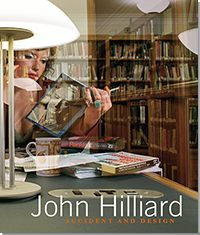Artist's Books / Special Editions
Almond, Darren: All Things Pass
Almond, Darren / Blechen, Carl: Landscapes
Brown, Glenn: And Thus We Existed
Butzer, André: Exhibitions Galerie Max Hetzler 2003–2022
Chinese Painting from No Name to Abstraction: Collection Ralf Laier
Choi, Cody: Mr. Hard Mix Master. Noblesse Hybridige
Demester, Jérémy: Fire Walk With Me
Dienst, Rolf-Gunter: Frühe Bilder und Gouachen
Dupuy-Spencer, Celeste: Fire But the Clouds Never Hung So Low Before
Ecker, Bogomir: You’re NeverAlone
Elmgreen and Dragset: After Dark
Förg, Günther: Forty Drawings 1993
Förg, Günther: Works from the Friedrichs Collection
Galerie Max Hetzler: Remember Everything
Galerie Max Hetzler: 1994–2003
Gréaud, Loris: Ladi Rogeurs Sir Loudrage Glorius Read
Grosse, Katharina: Spectrum without Traces
Hatoum, Mona (Kunstmuseum
St. Gallen)
Eric Hattan Works. Werke Œuvres 1979–2015
Hattan, Eric: Niemand ist mehr da
Herrera, Arturo: Boy and Dwarf
Hilliard, John: Accident and Design
Horn, Rebecca / Hayden Chisholm: Music for Rebecca Horn's installations
Horn, Rebecca: 10 Werke / 20 Postkarten – 10 Works / 20 Postcards
Huang Rui: Actual Space, Virtual Space
Kowski, Uwe: Paintings and Watercolors
Mikhailov, Boris: Temptation of Life
Mosebach, Martin / Rebecca Horn: Das Lamm (The Lamb)
Neto, Ernesto: From Sebastian to Olivia
Oehlen, Albert: Mirror Paintings
Oehlen, Albert: Spiegelbilder. Mirror Paintings 1982–1990
Oehlen, Albert: unverständliche braune Bilder
Oehlen, Pendleton, Pope.L, Sillman
Oehlen, Albert | Schnabel, Julian
Phillips, Richard: Early Works on Paper
Riley, Bridget: Paintings and Related Works 1983–2010
Riley, Bridget: The Stripe Paintings
Riley, Bridget: Paintings 1984–2020
Roth, Dieter & Iannone, Dorothy
True Stories: A Show Related to an Era – The Eighties
Wang, Jiajia: Elegant, Circular, Timeless
Wool, Christopher: Westtexaspsychosculpture
Zhang Wei / Wang Luyan: A Conversation with Jia Wei
 |
|
|||
John Hilliard: Accident and Design English / German
|
The photographs of British conceptual artist John Hilliard (born 1945) pose intricate questions to their medium. Since the end of the 1960s, the artist has taken that medium’s representational capacities to the proof, has made photos that are theses on perception, that critically expose photography’s inherent possibilities and flaws, while in turn creating his own striking images. In ever new experimental set-ups, he utilizes every means offered by the medium: double exposure, multiple points of view, changing perspectives, blow-ups, cut-outs, sequencing, superpositions, and much more. By these means, Hilliard explores what an image can tell you about the world and to what extent the apparatus itself will determine the meaning. Accident and Design surveys the artist’s work of recent years, with additions of selected earlier pieces to arrive at a focused stocktaking of artistic themes and issues. The essay by David Campany elucidates how through photography Hilliard was able to forge new paths after the endgame of conceptual art. Three programmatic texts by the artist reveal the theoretical foundations and practical approaches of his different work series.
ACCIDENT AND DESIGN Assuming photography’s most common purpose in representing the appearance of its objects to be mimetic, and given its origins in a period of naturalism in nineteenth-century European art, then as a strategy it can be compared to parallel endeavours within descriptive painting and drawing. The exactitude implicit in such practices seems to militate against a tolerance of the accidental – that is, occurrences beyond the intent or awareness of the creator. Nevertheless, unforeseen incidents may be seen to occur in the end-products of either discipline, although their locus may differ. As with a fisherman’s net, in addition to the main catch, the camera has the capacity to scoop up the unexpected. Indeed, such inclusions may even evade detection, unnoticed at the moment in which the picture is taken, overlooked during the printing process, only to be discovered (if at all) in the finished image – eliciting a frisson of pleasure or a pang of dismay, depending upon their perceived suitability. Such accidental inclusions may escape the initial awareness of the photographer as a result of the very nature of the process of recording. Within a practice ranging from spontaneous snapshots to painstakingly prepared pictures, most images will be ‘captured’ by the camera in a fraction of a second. Looking through the viewfinder immediately prior to that moment, elements may be moving unpredictably in front of the lens, a priority may be to target only a specific subject from within a complex field of view, and in any case the capability of eye and brain to have an equal and particular awareness of everything in the frame may be severely limited by time and restricted by the size and/or luminosity of the viewing screen. In such circumstances, a great deal of responsibility will be delegated to the disinterested mechanism of the camera itself. In the above description, it is the lack of conscious attention to, or lack of engagement with, every detail of the image during its production that leads to after-the-fact discoveries which can be seen, in retrospect, as accidents waiting to happen... The unheralded details found lurking in peripheral areas of the photograph are most likely to be acknowledged as a bonus at the very least, and at best elevated to pivotal status within the finished work. Recognising the significance of such accidental inclusions in a retrospective assessment is a legitimate part of creative responsibility. There is what is intended to be there and there is what has actually arrived, and the artist/photographer needs to be alert to both ends of the process. They must also be allowed the pleasure of discovering their own work – of knowing what they set out to achieve and seeing what has transpired: aware of both the similarities and the differences within that endeavour, prepared to be critical of any shortfall yet also willing to celebrate the presence of the unexpected and to welcome some accidental guests at an otherwise designed event.
... |